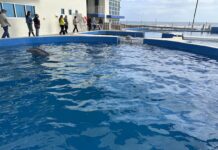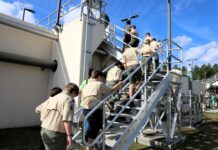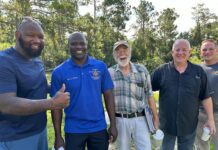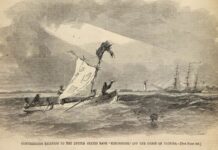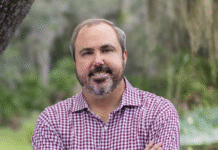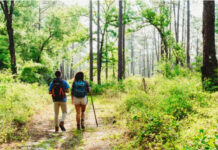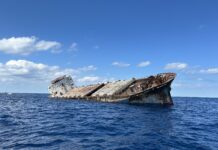JENNINGS, Fla. – The Florida Department of Environmental Protection has joined the Suwannee River Water Management District (SRWMD) in celebrating the designation of Jennings Bluff Tract in Hamilton County as the newest State Geological Site. These designated sites are areas that DEP’s Florida Geological Survey has determined to be significant to the scientific study and public understanding of Florida’s geological history.
SRWMD owns and manages more than 160,000 acres of land, however the Jennings Bluff Tract was chosen for this designation in part because of its hydrogeology. Water flowing into the Dead River swallet enters the Upper Floridan aquifer and travels south for approximately 10 miles before discharging through both Holton Creek Rise and the Alapaha River Rise in a matter of days. Numerous karst features exist on this parcel, and silicified oyster beds and other fossils can be found in the limestone walls exposed along the Dead and Alapaha rivers. The Miocene Hawthorn Group is exposed in the sinks and along these rivers.
The Jennings Bluff Tract is adjacent to the historic cemetery at Jennings Bluff, and stone tools from prehistoric Native Americans have been found in the area. These reflect the area’s significance in human history and demonstrate the geoheritage value, another criterion for State Geological Sites. It is important to note that collecting fossils or artifacts from district-owned land is prohibited.
“The educational value of this area cannot be overstated,” said Florida State Geologist and Florida Geological Survey Director Guy “Harley” Means. “There is no better place for teaching visitors how surface and groundwater systems are interconnected.”
“We appreciate the efforts of the Florida Geological Survey and DEP to designate these important sites,” said Hugh Thomas, Executive Director of the SRWMD. “This supports the district in its continuing mission to protect and preserve our natural resources, not just for us today, but for generations to come.”
State Geological Sites provide opportunities for experiencing and learning about Florida’s geological features, their connection to the local ecosystem, and their significance in past and present cultures. After the dedication ceremony attendees joined Means on a brief walk down to the Dead River swallet, where further discussions were had about the importance of this tract.
Legislation authorizes the state geologist to designate sites that are of great and continuing significance for the scientific study and understanding of the geological history of Florida. Seven sites have been designated, and the state geologist will identify more sites in the coming years. Torreya State Park was designated in 2021, joining Falling Waters, Edward Ball Wakulla Springs, Devil’s Millhopper, Florida Caverns and Windley Key state parks.
Media Release and Image: Florida Department of Environmental Protection




